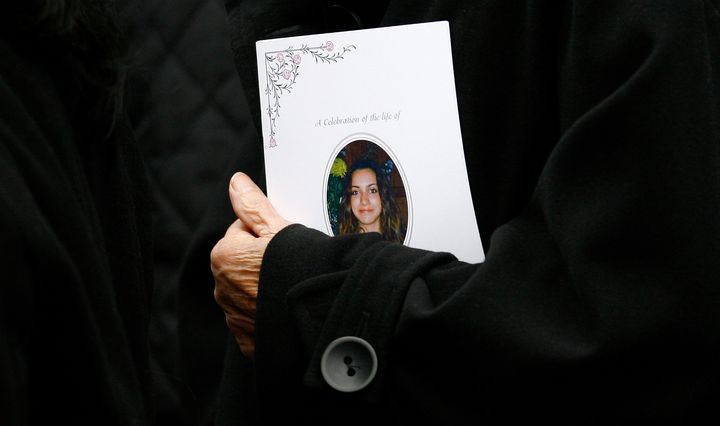
In October of 2011, I sat at work with my colleagues in our basement office in London’s Bloomsbury neighborhood, listening intently as BBC 1 anchors announced the acquittal of Amanda Knox and Raffaele Sollecito for the murder of Meredith Kercher. The mood in the room full of my British colleagues was one of disappointment: Kercher was a British university student whose violent murder was almost completely overshadowed by her “foxy” roommate’s alleged involvement in her death. The release of Knox felt like an incredible blow.
Five years after that acquittal ― following another appeal and Knox’s ultimate exoneration ― a Netflix documentary examines the whole story: the murder itself, the characters involved in the investigation and prosecution of the case, and the hurricane of press that accompanied the trial.
(Watch the trailer below.)
Featuring footage of the crime scene and original interviews with Knox, Sollecito, lawyers, detectives, prosecutors and one journalist who capitalized on Kercher’s murder and the mystery surrounding it, “Amanda Knox” offers a fascinating look at the way we demonize women perceived as “slutty.”
“I was quirky and I was OK with that,” Knox says in the documentary, about the young woman she was before studying abroad in the medieval Italian town of Perugia. “I thought of myself as a warrior princess...I remember thinking ‘OK, I’m different. I’m my own person, but I’m gonna find my place.’”
Shortly after moving to Perugia and moving into an apartment with Kercher, she met the handsome and romantic Sollecito, with whom she began an intense and passionate relationship. Five days after they first got together, on Nov. 2, 2009, Kercher was found dead.

Sadly, even years later, there is still no clear public consensus on who murdered Kercher. Despite Knox being exonerated (twice) by the Italian criminal system, as well as overwhelming evidence of Rudy Guede’s involvement and his eventual conviction for Kercher’s murder, many are still convinced of Knox’s guilt ― including Kercher’s family.
But one thing, regardless of who committed the murder, is absolutely certain: The case, and the subsequent public interest, was influenced by media coverage that focused more on Knox’s supposedly scandalous sexual history than the facts of Kercher’s murder.
The documentary shows that much of the speculation surrounding Knox’s involvement with Kercher’s death began with Italian Prosecutor Giuliano Mignini. From the onset of his investigation, Mignini appeared to revile Knox. He decided almost immediately that she was, at the very least, in part to blame for Kercher’s murder. No amount of evidence ― or lack thereof ― ever has convinced him otherwise.
Knox’s behavior in the immediate aftermath of Kercher’s murder was admittedly abnormal and arguably inappropriate ― what Knox might call “quirky”: as police investigated her home, she and Sollecito stood outside kissing and comforting one another. From this point on, Mignini ― a middle-aged Roman Catholic man ― never wavers in his unfavorable opinion of Knox. In fact, much of the evidence against Knox seems to stem from Mignini’s personal opinion. He believes that Kercher’s killer must be a woman, because “no man” would ever cover up the body of the woman he murdered. It was also Mignini’s conclusion that Knox, Sollecito and Rudy Guede (the man ultimately convicted of murdering Kercher) had killed Kercher because she was a prude and they were violent, enraged sexual deviants.
“Amanda was a girl that was very uninhibited,” Mignini says in the documentary. “She would bring boys home...If you could imagine a girl different from Amanda in every imaginable way, it would be Meredith.”
For Mignini, the fact that Knox enjoyed dating and having sex was enough to make her the bad guy. This would, of course, be the image that was painted of Knox in the press for years to come.
London-based reporter Nick Pisa covered the murder and trial for a number of British tabloids and fed into this narrative. A brief sampling of his headlines on the case included “Weeping Foxy is freed to make a fortune,” “Foxy Knoxy protests innocence and details her many lovers - and her fan-mail - in prison diary,” and “Sex crime? Foxy Knoxy and her boyfriend ‘just young lovebirds.’”
“A murder always gets people going,” he says in the documentary. “It was a particularly gruesome murder...what more do you want in a story?” The answer, apparently, was Knox: an attractive, young, blonde, white woman who put Pisa on the map for his coverage of her.
Pisa took the prosecutor’s theory of a “sex game gone wrong,” and ran with it. “To see your name on the front page with a great story that everyone’s talking about...it’s just a fantastic buzz. I’d like to say it’s like having sex or something like that, you know?” he said of the rush of reporting on Kercher’s death.
Murder cases involving female perpetrators (alleged or otherwise), are heavily sensationalized ― see Aileen Wuornos, Casey Anthony and Jody Arias. But considering how many men murder women ― each day in the United States, three women are killed by their intimate partners ― the disparity in how we talk about “bad men” vs. “bad women” says a lot about how much society enjoys the thought of a woman gone bad. In Knox’s case specifically, an alleged female murderer was significantly more interesting to the public than the young woman who was murdered. What does that say about us?
“I think people love monsters, and so when they get the chance they want to see them,” Knox says in the documentary.
In some ways, she’s right. People do love monsters. And they especially love when those monsters are (white, conventionally attractive) women.

On Thursday morning, Knox sat down with Robin Roberts on “Good Morning America” to discuss the upcoming Netflix documentary. “When you think about Meredith’s family,” Roberts asked, “do you think about how this is for them?”
“That’s the really sad part about this tragedy,” Knox responded. “As soon as the prosecutor made it about [me], they took away the fact that this case is about her and what the truth was about what happened to her. She’s been lost in all of that.”

“Amanda Knox” will stream on Netflix starting Friday, September 30.

